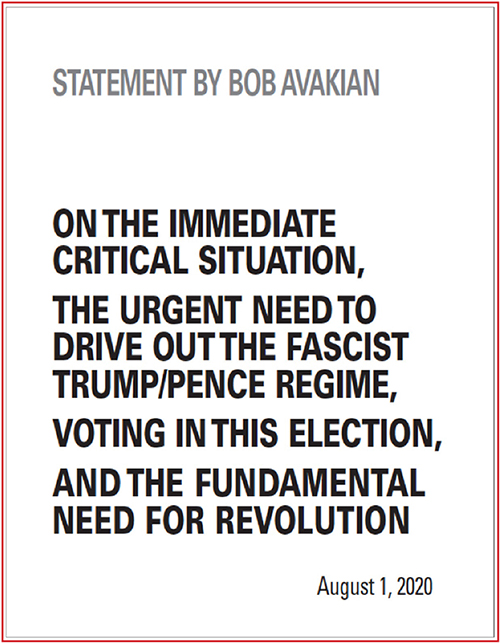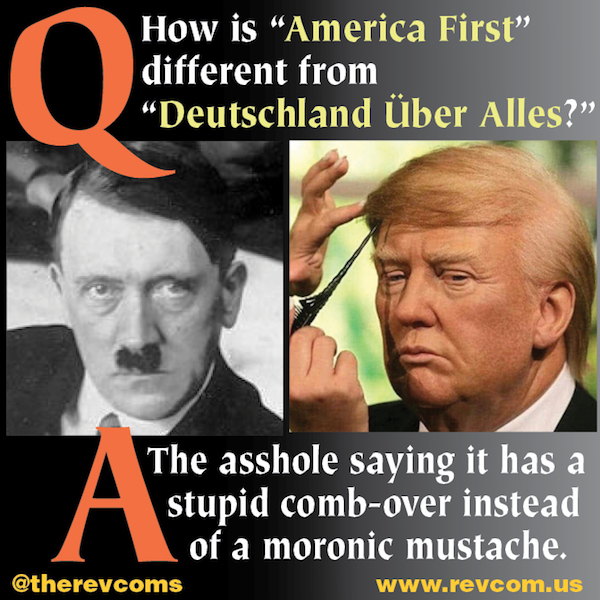The Fascist Pageant at the White House:
Anti-China Hate, Lies, and War Fever
by Raymond Lotta
| revcom.us
And so it goes in Trump's fascist telling in his RNC acceptance speech. China is “stealing our jobs” ... “ripping us off” ... “robbing our country blind”... and bent on “owning the country.”
Der Führer blamed China for the COVID-19 virus, using the racist label “the China virus.” The truth is that this virus is an animal-to-human pathogen (a disease-causing micro-organism). While the scientific consensus is that COVID-19 originated in China, Trump's insinuation that China deliberately spread the virus is utterly unfounded. Indeed, the evidence is that the likely source of the majority of infections in the U.S. is Europe. And let's be clear, this is one planet and a global pandemic. Trump's sensationalistic lies have been part of a sordid attempt to cover up the regime's criminal role in turning a public health crisis into an utterly unnecessary social-health catastrophe.
More ominously, Trump is whipping up war fever against China. He insisted that “China will be held fully accountable for this national [COVID-19] tragedy.” A few days earlier, he declared, “if I don't win...you're going to have to learn to speak Chinese.” At the White House, he boasted of being the only politican who can and will “stand up to China.”
Meanwhile, U.S. and China warships encounter each other in the South and East China Seas ... as the hired opera singer intonated “God Bless America” to the lunatic throngs on the White House lawn ... as the fireworks went off.
1) Setting the record straight about the U.S. economic relationship with China.
* Beginning in the late 1980s and taking off in the 1990s, China has been a cheap-labor/sweatshop “paradise” for U.S. and Western capital. American companies in high-tech, like Dell, Microsoft, and IBM shifted manufacturing operations to China. Workers on these production lines in the first decade of the 2000s were working upwards of 68 hours a week, being paid 65 cents an hour, and subjected to a relentless pace of work and cruel systems of control.
As the 2010s opened, most of Apple's iPhones were assembled in a single factory complex—in central, coastal China—that housed 450,000 workers! The 2017 factory cost of the iPhone, taking in all of its suppliers, was $237. But only $8.46 went to firms in China assembling the phone and producing its batteries. Of the final selling price of $649 at the time, $283 of the total gross profit went straight to the coffers of Apple.
Similar horror stories and financial windfalls could be told about apparel companies subcontracted by Target, and other large transnational U.S. firms “sourcing” production of low-priced consumer goods in China, Bangladesh, Mexico, elsewhere. The “Wal-Mart” price, largely based on “made in China,” has enabled U.S. capital to keep wages down and raise profitability. U.S. auto investments in China have allowed these companies to more directly penetrate a rapidly growing market—and this has been vital to overall corporate earnings and global competitiveness. The U.S. government has also collected duties and tariffs (these are like taxes) on goods entering the U.S. from abroad.
* China provided another source of stimulus for the U.S. economy. The Chinese government and banks derived revenues from the export sales of Chinese capitalist manufacturers to the U.S. and other Western markets. The Chinese government and banks invested a lot of that “foreign exchange” (generally dollars earned through export sales) in bonds issued by the U.S. Treasury. That money coming into the U.S.—its origins largely in sweatshop manufacturing—lubricated the U.S. economy. It helped make it possible for the U.S. government to run up (and finance) monumental deficits. More money was now sloshing through the U.S. economy, and that in turn stimulated growth and financial profits in the 1990s and 2000s, including through the housing boom and bubble.
* The U.S.-China relationship since the late 1980s, had been dominated by and overwhelmingly benefited U.S. capital—enhancing profitability.
But by the time of the 2007-08 global financial crisis, the U.S.-China relationship was growing more complex and changing. China is a rising capitalist-imperialist power. It has gained its own vast and independent economic strength and clout. China is now the world's 2nd largest economic power. China has become a technological innovator. Its currency and banking system play a growing role in global financial markets. China is investing heavily in other parts of Asia, Africa, and Latin America. China is challenging the U.S. for markets and global influence. And China is building up its military.
2) Setting the record straight about the loss of manufacturing jobs in the U.S.
* Yes, millions of manufacturing jobs have been outsourced and subcontracted from the U.S. to Mexico, China, and other parts of the “Global South.” Not because these countries are “stealing jobs” but because U.S. capital, facing intense international competition, roams the world in search of greater profit.
* The main reason U.S. manufacturing jobs have disappeared over the last few decades is technological transformation. Auto companies, steel firms, aerospace, and others have introduced robotics, worker-displacing equipment, information technology and more that have led to much higher output per worker ... and fewer workers! And U.S. firms have not only downsized but restructured work processes.
* Donald Trump has not reversed these trends. Yes, several hundred thousand manufacturing jobs were added in the three years up to the outbreak of the pandemic (although that happened under Obama, too). But the share of manufacturing jobs in relation to total U.S. employment has declined sharply in the past few decades: from 28 percent in 1960 to a post-World War 2 low of slightly over 8 percent today. These jobs are not coming back—no more so than agricultural jobs that used to be at the heart of the U.S. labor force ... but which were mechanized out of existence.
U.S. capital depends on global, cheap-labor supply chains. These chains move and morph throughout the “global south.” The profitablity and very functioning of U.S. capital requires super-exploitation in the Third World. It's why the Trump administration pressured the Mexican government to keep factories controlled by U.S. capital open as the pandemic hit, churning out goods for the U.S. and global market.
3) Anti-China xenophobia and escalating war moves. The U.S. military under Trump has been guided by and is operating according to a new National Security Strategy enunciated in 2018. That strategy is nothing less than a dark vision for U.S.-China conflict. As Trump chest-thumped to the TV audience—and reminded China—he has presided over an enormous military build-up (and this build-up includes expanded nuclear-war waging capacity). [See “The Absurd and Dangerous Fantasy That Donald Trump Is Not a War Monger”]
Trump's acceptance speech was the culmination of a RNC Hitlerian pageant. A virulent step in the racist-fascist juggernaut of clampdown at home and escalating moves towards war.
Get a free email subscription to revcom.us:



